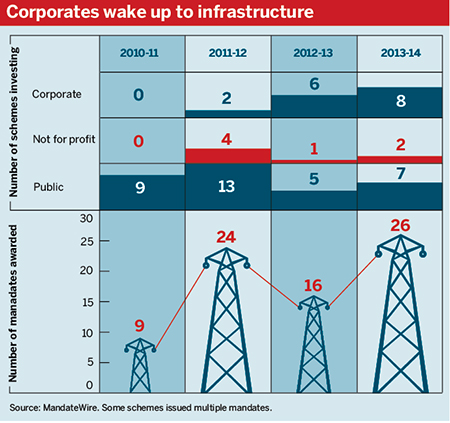Corporate schemes are catching up with their public sector counterparts in accessing the illiquidity premium of infrastructure investments, taking an increasing share of a growing asset class.
Infrastructure has been lauded as a useful asset to match pension funds’ long-term liabilities, however investment has been slow, with consultants blaming lack of asset availability, transparency issues and fees.
Data from Financial Times service MandateWire show a significant increase in the number of awarded mandates to infrastructure over the past year.
The figures show 26 new mandates were awarded to the asset class in the year to August 31 2014, compared with 16 in the previous year. In 2010-2011 only nine new mandates were awarded.
There has also been a marked shift in the type of scheme investing (see graphic). This year the data show nearly half of those investing in the asset class were corporate pension funds. This is a significant difference to 2010-11 when all awarded mandates were from public sector schemes.
Nick Spencer, director of alternatives at Russell Investments, said there has been a lot of interest in infrastructure and real assets.
“We are seeing now the evidence of those investments going ahead,” he said. “There is a lot to look at in the asset class and to understand, and naturally that takes time.”
The corporate schemes investing will most likely be larger and looking on a longer-term basis. “These are long-dated assets, so these are schemes that have a viable future out into the distance,” Spencer said.
According to the National Association of Pension Funds’ 2013 annual survey, 17 per cent of defined benefit schemes are invested in infrastructure compared with 15 per cent in 2012 and 14 per cent in 2011.
Of the schemes that invest in the asset class, the average allocation has increased to 3.2 per cent in 2013 from 2.7 per cent in 2011 and 2012.
Strathclyde Pension Fund this year awarded multiple mandates to renewable energy, including onshore wind.
Celene Lee, senior investment consultant at Buck Consultants, said it has seen evidence of some mid-sized schemes investing in infrastructure funds but warned them the asset may not exhibit the characteristics they seek.
“We are also seeing mid-sized pension schemes accessing infrastructure via the diversified growth fund route,” she said. “We are also seeing a preference for listed rather than unlisted infrastructure, potentially because of its simplicity in concept in terms of how you invest.”
Marcus De Kock, investment consultant at LCP, said direct infrastructure is not something the consultancy is keen on for its clients, arguing the lack of transparency and private equity-style fees are not suited to pension schemes.
He added: “Infrastructure is difficult to justify. We’re keeping a close eye on development in the Pensions Infrastructure Platform… to date, we’ve not seen a significant improvement in that [direct infra] space.”
Once local authority schemes have concluded their triennial valuations, Spencer expected there to be further allocations.
He added there has been interest in smaller sized deals.
“We are looking for assets… that are less GDP-sensitive, which can be involved in some sort of power generation,” he said.














